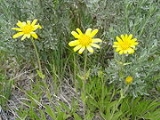
Arnica sororia
Encyclopedia
Arnica sororia is a species of arnica
known by the common name twin arnica. It is native to western North America from British Columbia
to California
to Nebraska
, where it grows in many types of habitat.
It is a rhizomatous
perennial herb producing one or more hairy, glandular stems 10 to 50 centimeters tall. There are several pairs of broadly lance-shaped leaves along the stem, the lower ones borne on petioles
. Leaves may reach up to 14 centimeters long.
The inflorescence
holds one to five daisy-like flower heads
lined with phyllaries
coated in glandular hairs. The flower head has a center of glandular yellow disc florets and a fringe of yellow ray florets. The fruit is an achene
a few millimeters long with a white pappus
.
Arnica
Arnica is a genus with about 30 perennial, herbaceous species, belonging to the sunflower family . The genus name Arnica may be derived from the Greek arna, "lamb", in reference to the soft, hairy leaves....
known by the common name twin arnica. It is native to western North America from British Columbia
British Columbia
British Columbia is the westernmost of Canada's provinces and is known for its natural beauty, as reflected in its Latin motto, Splendor sine occasu . Its name was chosen by Queen Victoria in 1858...
to California
California
California is a state located on the West Coast of the United States. It is by far the most populous U.S. state, and the third-largest by land area...
to Nebraska
Nebraska
Nebraska is a state on the Great Plains of the Midwestern United States. The state's capital is Lincoln and its largest city is Omaha, on the Missouri River....
, where it grows in many types of habitat.
It is a rhizomatous
Rhizome
In botany and dendrology, a rhizome is a characteristically horizontal stem of a plant that is usually found underground, often sending out roots and shoots from its nodes...
perennial herb producing one or more hairy, glandular stems 10 to 50 centimeters tall. There are several pairs of broadly lance-shaped leaves along the stem, the lower ones borne on petioles
Petiole (botany)
In botany, the petiole is the stalk attaching the leaf blade to the stem. The petiole usually has the same internal structure as the stem. Outgrowths appearing on each side of the petiole are called stipules. Leaves lacking a petiole are called sessile, or clasping when they partly surround the...
. Leaves may reach up to 14 centimeters long.
The inflorescence
Inflorescence
An inflorescence is a group or cluster of flowers arranged on a stem that is composed of a main branch or a complicated arrangement of branches. Strictly, it is the part of the shoot of seed plants where flowers are formed and which is accordingly modified...
holds one to five daisy-like flower heads
Head (botany)
The capitulum is considered the most derived form of inflorescence. Flower heads found outside Asteraceae show lesser degrees of specialization....
lined with phyllaries
Bract
In botany, a bract is a modified or specialized leaf, especially one associated with a reproductive structure such as a flower, inflorescence axis, or cone scale. Bracts are often different from foliage leaves. They may be smaller, larger, or of a different color, shape, or texture...
coated in glandular hairs. The flower head has a center of glandular yellow disc florets and a fringe of yellow ray florets. The fruit is an achene
Achene
An achene is a type of simple dry fruit produced by many species of flowering plants. Achenes are monocarpellate and indehiscent...
a few millimeters long with a white pappus
Pappus (flower structure)
The pappus is the modified calyx, the part of an individual disk, ray or ligule floret surrounding the base of the corolla, in flower heads of the plant family Asteraceae. The pappus may be composed of bristles , awns, scales, or may be absent. In some species, the pappus is too small to see...
.

